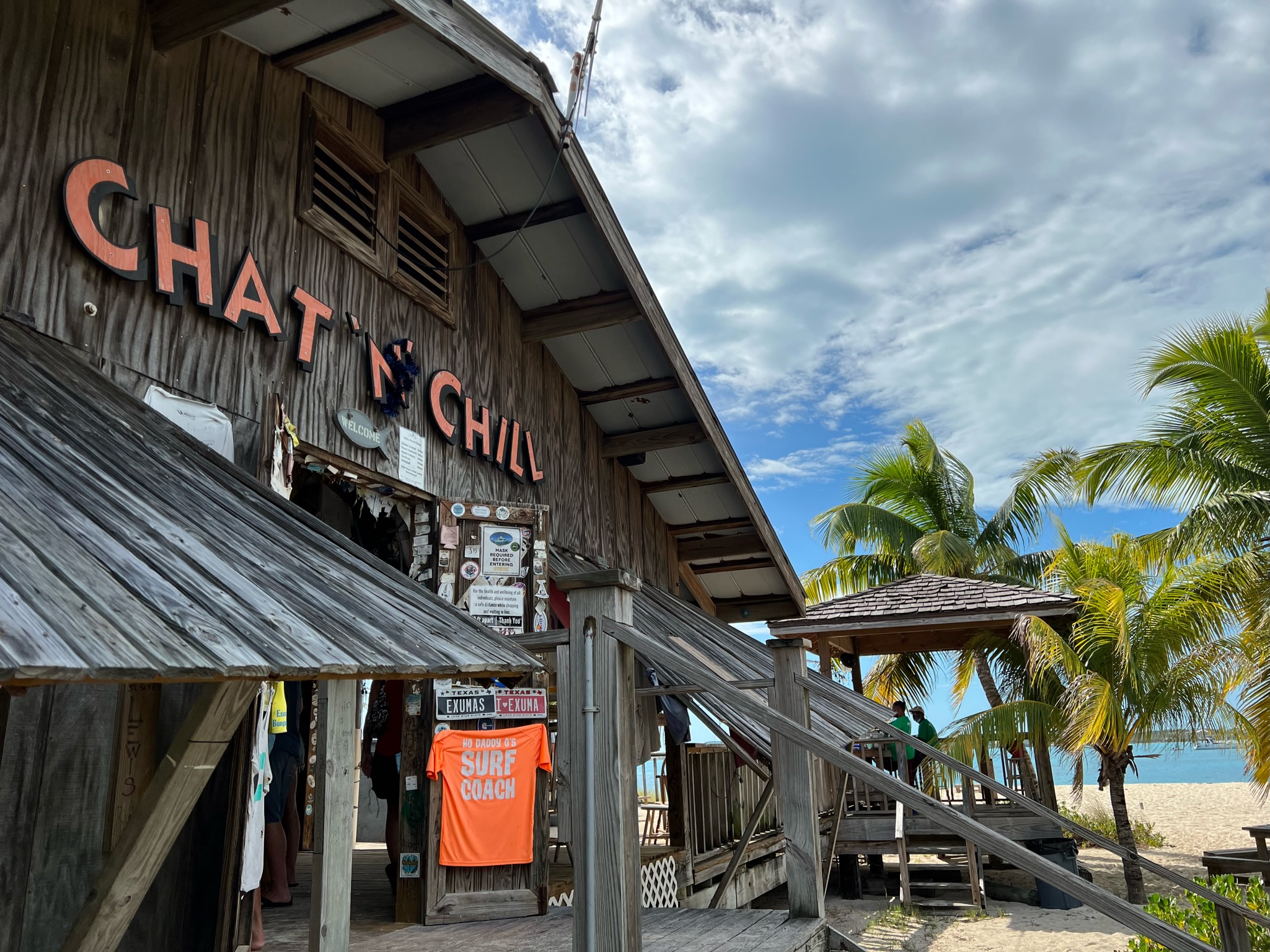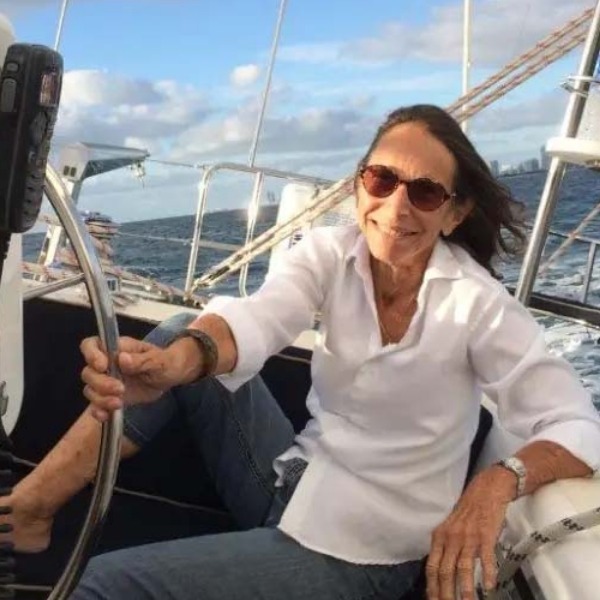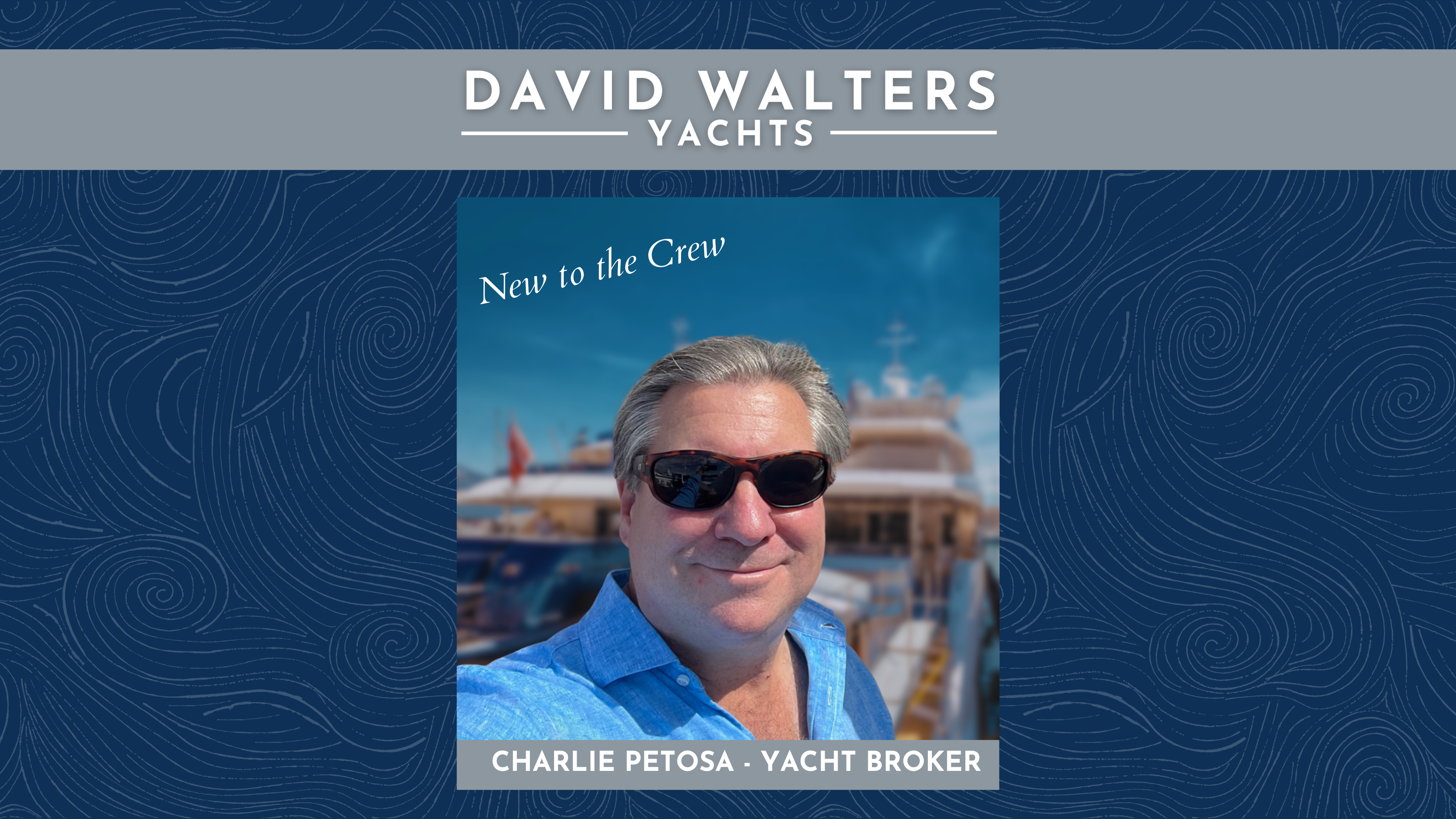The Best of the Bahamas Part II by Pam Wall
We're back with lifelong sailor and cruise consultant Pam Wall with more tips and recommendations of her favorite places in the Bahamas.
If you missed Part I of this Bahamian double feature, head to the first post here to get to know a little bit about our friend Pam and the first half of her favorite places in the Bahamas. Quick recap: Pam has led an incredible life of adventure on the high seas, notably sailing around the world with her husband and young children on their home-built Freya 39, Kandarik, for nearly seven years in the late 1980s. These days she shares her extensive knowledge and experience as a freelance cruise consultant, frequently presenting at boat shows around the world.
*We want to note that the picks included in these blog posts are not all there is to discover in the Bahamas! Take these posts as a guide for how to get started exploring Pam’s favorite islands in the world, and feel free to reach out to her with any questions.
For Part II, we're going to backtrack a bit to catch up on some spots and extra tips we missed between the Abacos and the Exumas, adding info in the Exumas as well, and then we'll finish out with the unspoiled Out Islands. According to Pam, to get the best sailing, anchorages, and fresh food from the sea, you really don't have to go anywhere beyond the beautiful Bahamas, making them her favorite islands in the whole world. And luckily they're so accessible to those of us here in the States! The depth of Pam's knowledge is truly breathtaking, and she invites anyone interested in discussing anything we've covered (or not!) to reach out via email to pam@pamwall.com with questions.
Leaving Little Harbour
As you may recall from our first Bahamas post, the 360°-protected Little Harbour is the last southerly harbor in the Abacos, and home to the artistic Johnston family: owners, operators, and artisans of the Johnston Art Studio, The Art Foundry, and Pete's Pub, three must-stop spots in Little Harbour. After you've picked up a bronze sculpture and fueled up on grub from the pub (hello fresh fish caught daily!), you'll want to pull out your Explorer Chartbook by Sara and Monty Lewis to get your compass course to head south to Spanish Wells in Eleuthera. It's about a 45-mile passage from Little Harbour to Spanish Wells with the wind out of the E and ESE, which will give you a close reach if sailing. You'll want to leave early in the morning and be cautious going out to sea from Little Harbour depending on your draft. With KANDARIK’s 6.5' draft, Pam always makes sure to go at half tide rising so that if she hits the sand bar, she knows her boat can get off shallow water easily as the tide continues coming in. Leave the Little Harbour lighthouse to starboard and head into the Atlantic SSE to cruise down to Eleuthera.

Your boat will have to go inside the bank to get to Spanish Wells, and there are a couple options to get from the deep water into the shallow water. You can go through Egg Island Passage at any state of tide as you approach the shallow bank and then you can anchor where you are comfortable in the shallow water of the bank, or you can head into Royal Island. The entrance to Royal Island is a bit tricky, with a rock in the middle of it. Keep the rock to starboard and the island to port–do not go on the other side of the rick. Once inside the island, you’ll have a good anchorage and a great night’s sleep in a lovely, quite spot after your passage from Little Harbor. From Royal Island, it’s just a few miles and a shallow sail to Spanish Wells proper, with the entrance to Spanish Wells on your port side. Once inside the harbor of Spanish Wells, if you head to port, you can go to the little marina, or go starboard to mooring buoys, great grocery stores, a haul-out facility, and one of the most beautiful sand beaches on the north side. With great protection, excellent shopping, and such a pretty beach, it would be easy to stay there for a long time!
The Bight of Eleuthera
In the big group of islands east of Spanish Wells, there are several nice, comfortable anchorages and natural harbors. We mentioned the Devil's Backbone in the first post, and Pam reiterates her recommendation to take a guide and sail through the 5 miles of coral heads to Harbour Island. Go when the sun is overhead to easily sashay around the coral heads, which are easy to spot in the deep water that surrounds them. One of the wonderful guides for hire will be a great help in getting through without incident, especially if it’s your first time. The fancy waterfront area of Harbour Island features fantastic mega yachts, beautiful (expensive) marinas, lovely hotels, and a nearby airport so friends can fly from Florida to meet you. The best attractions of Harbour Island are definitely the beaches on the northeast side of the island. After you've explored Harbour Island, you can head back across Devil's Backbone back into the Bight of Eleuthera, perhaps on your own if you're comfortable after having made it one way with a guide.

You can head down to Current Cut to get to all the out islands and towns along the west and south of Eleuthera Island, all of which are worth visiting, each offering its own unique charm. Make sure you look at tidal charts to go through Current Cut; if you are without a lot of engine power to go against the current, you have to go with the tide either flooding or ebbing (depending on whether you're coming or going), so you can get shot through with the current. It would be unwise to try to get through Current Cut unless you have the tide with you. Trust Pam!
As you head down the inside of Eleuthera, you'll end up at Ship Channel Cay in the northern tip of the Exumas. If you'd rather get straight from Spanish Wells to the Exumas, you have to go south from Spanish Wells on the west side of Current Cut and go through Current Cut into the Bight from the west to the east and then sail south about 45 miles to Ship Channel Cay. That means you should probably leave early in the morning, depending on the speed of your boat. Hopefully the wind will be out of the east for a nice beam wind, and Pam suggests going on a clear day when you can spot the dark color of the coral heads in the sandy bottom and sashay around them. It's a beautiful, fun sail in fairly shallow water with no sea, and not scary at all if you choose your weather well and scoot along with the sun above you, always with someone watching out for the dark round spots of those shallow coral heads.
The West Side of the Exumas
Once you reach Ship Channel Cay, now you can go down the west side of the Exumas, stopping as often as you want in the most beautiful places. You're on the leeward side of the Exuma islands with wind from the east; you'll want to consult your Explorer Chartbooks to navigate around the big sand bars and keep to the deeper areas. It's spectacular sailing with crystal-clear waters showing the sandy shallow spots falling away into a deep turquoise that you can see through all the way to the bottom. Pam loves to tow a long line aft with a spinner hook as she sails along the way, catching a nice fish for dinner.
Allan's Cay
If you're a fan of iguanas, Allan's Cay is a great spot to stop and see them in the protected anchorage inside the island, however, Pam prefers not to anchor there because there's so much current. If you do decide to anchor in Allan's Cay, you'll want to anchor in the Bahamian mooring style, with one anchor up-current and one down-current so your boat can swivel from one direction to the other but will remain in the same position when the current changes; be sure your propellers don't get caught when your boat swings with the tides. Pam always sets Bahamian anchors a bit upwind of her boat position so her prop doesn’t get caught on the eased anchor rode when the boat swings. Pam prefers to anchor outside the island with no current and lie to the wind. It can get a bit crowded when the fast tourist boats zip over from Nassau to bring groups of iguana gawkers to Iguana Beach, but if you don't mind sharing the lizard sightseeing, it can be a fun activity for families with kids especially.

Highborne Cay to Warderick Wells Cay
Two beautiful sandy beaches on the west side of Highborne Cay offer great anchorage, and the lovely marina is a nice spot to fuel up, get water, and enjoy an ice cream bar while admiring the big, gorgeous boats that stop in at this upscale marina. When you're anchored off of Highborne Cay, your stern will be facing west with all open water, so if a cold front comes in, you'll be turned around and you could experience very choppy anchoring conditions in west and northwest winds.
From Highborne Cay, you can set off at lunch and make it to Norman's Cay before dark (take care that you always go way around Norman's Spit sand bar; there is no shortcut!). We talked about Norman's Cay in depth in the first post, but Pam adds that you'll need to do the Bahamian mooring once you're in the southerly tidal anchorage called the Slot. North of where you'll anchor, you'll see a great big Bight of pearly sand, and to the east, tiny little islands surrounded by more gorgeous sand when the tide is falling. You can spend a whole day in your tender going across shallow banks and exploring the isolated beaches, searching for conch in two feet of water, and braving the mangrove swamps to explore and find a way into the beautiful, deep Norman's Pond, where nurse sharks swim around the boat and white owls dwell in a huge cave facing the water’s edge. If you’re interested in specific routes into the pond, contact Pam!
Shroud Cay is the next spot we visited in Part I, where you should also launch your dinghy to explore the shallow creeks and canals, and sift through the beach sand for sunray talons, sand dollars, sea biscuits, and more treasures like starfish that wash up on the beautiful white sand beach.

Follow your charts to Warderick Wells Cay, the headquarters of the Exuma Cays Land and Sea Park (ECLSP), established in 1958 and governed by the Bahamas National Trust to preserve and maintain the delicate ecological balance of Bahamian marine life. Put your fishing gear away and make a mooring reservation over VHF radio to spend some peaceful time in this phenomenal protected area. The crawfish population in the park abounds, such that you'll see them peering up at you from under the moorings as if they're taunting you, "Ha ha, you can't catch me!" It’s against the law to catch any fish or crayfish or conch in the park. The best thing to do is explore the whole park by dinghy, going south out of the anchorage area along Warderick Wells, and landing to explore the park paths, where the once endangered chubby rodent population of hutia has rebounded in spades; they are a now common sight particularly after sunset. If you go to the south end of Warderick Wells Cay and turn to port, another harbor with mooring balls is usually empty, offering a quiet, peaceful night for just you, a breakwater of coral, and a beautiful beach away from the action of the main harbor of Warderick Wells.
Conch Cut to Sampson Cay
Near Warderick Wells Cay, Conch Cut lets you back out from the banks into the deep water of Exuma Sound. Like many of the cuts in the area, it can be very frightening if you don't go out (or come in) with the current. If you make the mistake of going out the passes against the current with the strong east wind against your boat, you will find big rollers working against you. Save yourself the trouble and go out with the outgoing or falling tide (and the opposite for coming back in). It can be a wicked 4-6 knots, but it makes for a spectacular sight when you're coming in with the incoming tide and get shot from the purple water of Exuma Sound into the turquoise shallows—get your camera out.
Take Conch Cut to Sampson Cay, which used to be open to the public but is now private. At the north end of the cay, there is a pretty anchorage and a building ashore. Depending on if the owners are home, you can anchor there and politely ask if you can look around the private docking area with huge docks for enormous power boats, a grocery store, and private facilities. If you can't go ashore, you can still take your tender around to get a peek. East of the docks, there is a beautiful beach where you can land your dinghy and walk across the island to another beautiful white sand beach where you can walk out a quarter of a mile with the water just up to your belly button. From there, you can take your dinghy or make the easy but twisty passage by sailboat from Sampson to Staniel Cay, a spot we covered more in depth in Part I.

In addition to the Staniel Cay highlights we talked about last time (like Thunderball Grotto and Pig Island), there is also an airport with direct flights to and from Ft. Lauderdale, making it a popular destination. If you're willing to spend a little more to dock at the yacht club, make sure you're going up-current to get in, or you can anchor off the club with that Bahamian mooring style you're getting to know so well. The holding ground there is very poor because it's scoured by the current, so make sure you go in with a mask and snorkel to ensure your anchors are secure, or lie to the wind at Pig Beach and take your tender into Staniel Cay instead. The legendary Out Island racing boats used to be built here, and the funny grocery store is worth a trip.
Black Point to Elizabeth Harbour
Seven miles southwest of Staniel Cay is a cute settlement called Black Point with a great big bay to safely anchor. It’s quite shallow close to the land, so you'll anchor with 2-3' under keel pretty far from the beach but protected from the east wind. Black Point has adorable restaurants, grocery stores, and beautiful walks, and will host the Ocean Cruising Club's winter rendezvous. And it's a fabulous place to be to experience Junkanoo.
Black Point is as far south in the Exumas chain you can sail south on the banks unless you have a shallow draft boat, but if not, to get to your next stop, you'll go back up north of Staniel Cay and out through Dotham Cut into Exuma Sound and then sail down to Farmer's Cay. The cut into Farmer's Cay is wicked; you'll get in fast if you go with the tide. Turn south when you’re inside the cut to find the big open bay, which isn't very deep, so you'll anchor on the outside of the bay and take your tender across to the adorable Little Farmer's Cay islet to visit the grocery store and the restaurant for an alfresco meal. Head out early in the morning with the outgoing tide to get shot back out the cut into Exuma Sound and head down the coast all the way south 45 miles to Elizabeth Harbour, a beautiful, large, protected natural harbor.

When the wind is howling out of the east, the entrance to Elizabeth Harbour can look scarier than it is, but if you follow your charts carefully, to avoid sand banks, it's deep enough to go through safely. You can anchor off of Rolletown and try to get into their little marina around the corner, or follow the beaten path to where most folks anchor in the lee of Stocking Island. Stocking Island protects Elizabeth Harbour from east and southeast winds and has beautiful beaches with lots of homes and three little holes, the most famous of which is the gorgeous, yet crowded, Volleyball Beach, a place to see and be seen. If you'd rather not join the throngs there, you can anchor in the lee of Stocking Island itself. To tie up your tender in town, you will find a pass through a tunnel into the Victoria Harbour lagoon where there's a floating dock for dinghies to go ashore, and with a marina and every other convenience you might need while cruising. It’s a good check-in point for entering the Bahamas from somewhere further south like Jamaica or the West Indies. If you’d rather visit a less bustling harbor than Elizabeth Harbour, a bit further north is Emerald Bay Marina before Elizabeth Harbour on the north side as you are sailing down the Exumas chain, which has a marina and an airstrip with flights to Florida. Emerald Bay Marina is just a bit more difficult to get into when there’s a raging sea.
To the Out Islands
Elizabeth Harbour is a great jumping off point for those looking to explore the rest of the Bahamian islands. The Jumentos Cays are a group of beautiful islands to the south that are spectacular to visit, but they don't have great anchorages for a lee if there's a west wind in wintertime, so there's not much protection if a cold front comes through. If you want to get to Long Island to the east, you will find a strong easterly beat to windward to also sail to Cape Santa Maria on Long Island due east of Georgetown 60 miles. It's a long way to go upwind, but there's good anchorage in the lee of the lighthouse, with the beach protecting you from the east wind. From Cape Santa Maria, you can get to the out islands east of the Exumas, like Rum Cay, Conception Island, and San Salvador.

Pam's favorite out island is Conception: there are no structures on it and the water is just unbelievably clear. The bay you anchor in is so full of fish and crawfish, you are practically guaranteed a delicious fresh-caught dinner. The last time Pam visited, she took a dip and found herself face to face with a shark! Luckily, she made it back into her boat unscathed and lived to tell the tale. Talk about adrenaline!
Rum Cay has an adorable little harbor, but if you're unsure your boat's draft will make it into the small harbor and want to ask a local, make sure you ask, "How many feet can I take into the harbor?" If you ask, "Can I take my boat with X amount of draft into the harbor?" you will almost certainly receive a, "Yeah, mon!" no matter what your draft is from the friendly Bahamians who want to make you happy. If your draft is too much for the harbor, you can anchor off the cay and go in with your tender. Wear bug spray if you're visiting in the evening; Rum Cay tends to have a nightly influx of pesky no-see-ums.
San Salvador has the most gorgeous beaches and delightful local goods, like fresh Bahamian bread you can smell from your boat at anchor off the main beach, and straw hats and jewelry made from local, natural materials. Cat Island to the west of San Salvador and Crooked Island to the south also have gorgeous beaches, beautiful anchorages, and very friendly people. All the out islands tend to have few yachting visitors, making them uncrowded and ripe for relaxation and exploration. And you will find the clearest water for swimming, snorkeling, catching fish, and shelling on the lovely white sand beaches. But always remember, no spearguns allowed in the Bahamas—only Hawaiian slings, so be sure the bring one with you!
Further south lies Great Inagua, our last stop in the Bahamas, with nothing but a big, open anchorage. It's a bit rolly to get into the tiny harbor, but from there, you can venture out of the Bahamas and on to the Dominican Republic and Haiti to San Juan, Puerto Rico, to the Virgin Islands, then to Antigua, and then all the West Indies. If you want to go from the Bahamas non-stop to the Virgin Islands, Pam recommends taking the Northeast Providence Channel straight out to the east until you hit "Route 65," 65° W, the Virgin Islands' longitude. Turn to the south with the east wind on the beam, pole out your genoa, and scoot south 1200 miles to make landfall in St. Thomas where you can check into the Virgin Islands. If you take that route rather than trying to take the hypotenuse of the triangle, you avoid the frightening situation of getting caught on shallow banks like the Navidad Bank, the Mouchoir Banks, and the Silver Banks north of the Dominican Republic and Hispaniola. And with that bonus tip for leaving the Bahamas behind, this concludes Part II of Pam Wall's Bahamian recommendations! If you would like Pam’s List of essentials to take to the Bahamas aboard your boat, send her an email and she will be happy to email it to you right away.

If you haven't taken our poll yet, click here to vote on where we should have Pam take us next! And keep an eye out for future collaborations with Pam and David Walters Yachts. As always, you can learn more about Pam at pamwall.com and reach her at pam@pamwall.com with any questions you have about cruising. Thank you to Pam for sharing her Bahamian knowledge with us once again! We look forward to what comes next.
Make sure you're following us:










LEAVE A COMMENT